Training of Slum-dwellers for Observation of
Municipal‑Water‑Supply Quality.
Why marginal communities should watch for the quality of their water supply?
All residents have a right to access safe drinking water from their respective municipal agencies. However, marginalised communities & slums-dwellers, often face intermittent supply on alternate-days, tridaily and/or biweekly supply. Low pressure and short-duration supply may restrict the volume of water available to residents of these areas. Every now and then, slum-dwellers come across signs and symptoms of poor-quality water supply, such as foul smell, turbidity, etc. Faced with daily changes in household water access, slum-dwellers purchase canned water from local bottled water suppliers and bear the financial burden. Inadequate and/or poorly maintained distribution infrastructure, coupled with operational neglect of underserved areas appears to be contributing factor. A study on drinking water supply for urban poor in Hyderabad found that, most slum-dwellers reported poor perception about the quality of water (Safe Water Network, 2016). A study in Bhubaneswar found that many slums did not have access to safe drinking water (Times of India, 2023). A study by Kalam Institute of Sciences found that 10 out 18 samples collected by them did not pass the biological and chemical tests (Times News Network, 2017). A survey of selected slums in GHMC area reported that, slum-dwellers did not have enough water to meet their needs (Sreepada SV and Goswami S. 2018).
However, many slum-dwellers are not fully aware of the importance of adequate residual chlorine to protect the municipal water supplied through the distribution network connecting their households taps of public standposts to the concerned service reservoir and ultimately to the central water treatment plant. While people can sense obvious water quality issues like foul smell, turbidity etc., information and education about usefulness of structured observation of supply characteristics and laboratory testing would empower them to fruitfully engage with water supply authorities for appropriate remedial action. For example, careful observation and reporting of the appearance, duration and disappearance of turbidity and characterization of smell by multiple observers, can help water utility officers to identify the nature of problem. Similarly, communities can, with some training, monitor residual chlorine in liver metro water supply to their neighbourhoods and report deficiencies if any for quick action. On the other hand, clean & odourless water supplied through vulnerable water distribution network, may be perceived as safe, but is not necessarily free of contamination. Regular laboratory testing for detection of E. coli is required to assess vulnerability and establish integrity of water distribution network connecting slum-dwellers’ house taps and public standposts. Formal and informal community organisations can get their water supply tested by independent laboratories to draw attention of water utility authorities for remedial action.
Training of Slum-dwellers and ‘Basti Mitras’ in Cherlapalli & Dammaiguda area; in collaboration with MARI:
Modern Architects for Rural India (MARI) was started by a team of young professionals with social work background having a desire for heralding change towards egalitarian society. Their vision is to empower vulnerable sections of the society to fight against poverty, injustice and the environmental degradation that threatens their basic livelihoods. MARI’s Basti Vikas project in Hyderabad, seeks to develop basic amenities (water, sanitation & waste collection) in six selected slums in Cherlapalli and Dammaiguda area. MARI’s Project Director asked IHS Laboratory for technical support to train community members and cluster facilitators (Basti Mitra’s) on water quality testing and build awareness of slum-dwellers on water quality issues. These programs were organised in the 1st week of December, 2025.
A water supply observation form was designed to train consumers in observation of relevant supply characteristics for reporting of water supply related issues, identification systemic water distribution deficiencies if any and to facilitate meaningful engagement with water utilities to resolve problems and improve water safety. The IHS laboratory team for each camp consisted of a primary resource persons and an observer. On 2nd December, three camps were held simultaneously at; (a) Pukat Nagar, Cherlapally; (b) Surendra Nagar, Narapally, and (c) Gandhi Nagar, Cherlapally. On 3rd December, another three camps were held simultaneously at (d) Shanti Nagar, Dammaiguda, (e) Yadamma Nagar, Dammaiguda, and (f) BJR Nagar, Dammaiguda. Altogether about 145 residents spread over the six slums participated in the program. In addition, 14 staff / volunteers of MARI including the cluster coordinator, facilitator and basti mitras were trained in residual chlorine testing and sample collection procedures.
Pukat Nagar:
MARI’s Cluster- Coordinator (J. Ashok) & Basti Mitra (K. Jyothi), present.
IHS Laboratory Team: Ms E. Shravanthi, Associate Microbiologist (Resource Person); Ms Ch. Madhuri, Associate Microbiologist (Observer).
Date: 02-12-2024; Participants: 30
Pukat Nagar: IHS Team Demonstrating RC Testing.
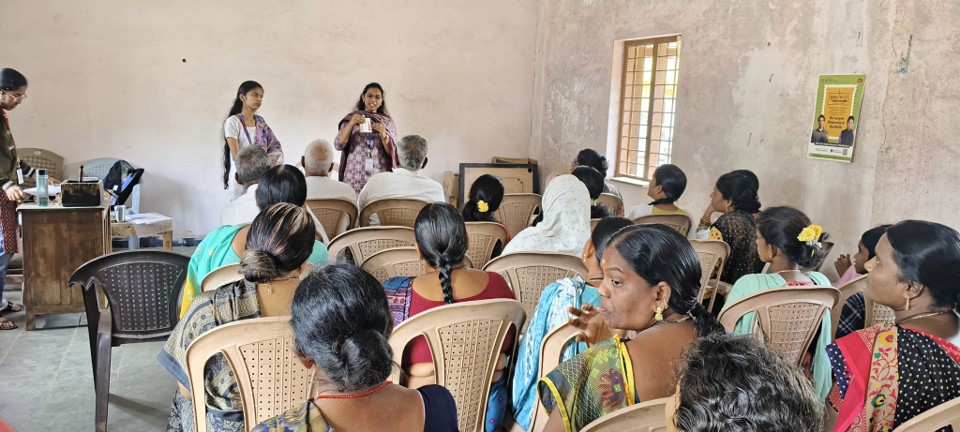
During the course of introductions, the participants informed that, in the past, the water supplied to their neighbourhood had issues like turbidity and sometimes a dirty smell. Recently the metro water people have attended to their complaints and the water quality has improved. Now a days, they are using metro supply for drinking purposes.
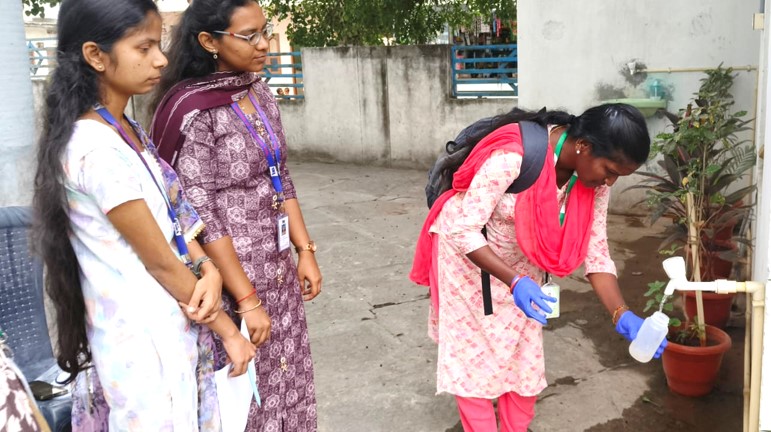
Pukat Nagar: Sample Collection - Practical.
IHS Team explained the source of metro water, how it reaches their basti, role of central treatment plants and service reservoirs. Distributed water supply - rating sheets and explained how consumers can assess and describe observable aspects of their water supply. Cluster- Facilitators helped participants read and answer each item in the rating-sheet. Resource persons demonstrated residual chlorine tests of live metro supply in 10 households. Nil RC in all samples. Explained how to raise a complaint via toll-free number and HMWSSB citizen services app. Collected two household & one SR samples for laboratory testing.
Surendra Nagar:
MARI’s Cluster- Coordinator (K. Ashok) & Basti Mitra (M. Jyothi), present.
IHS Laboratory Team: Mr. PS Revanth Kumar, Intern in Environmental Management & Chemical Laboratory Technique (Resource Person); Ms Boorla Manasa, Senior Microbiologist (Observer).
Date: 02-12-2024; Participants: 20
Surendra Nagar: MARI Coordinator Introducing the Training Camp & IHS Team.
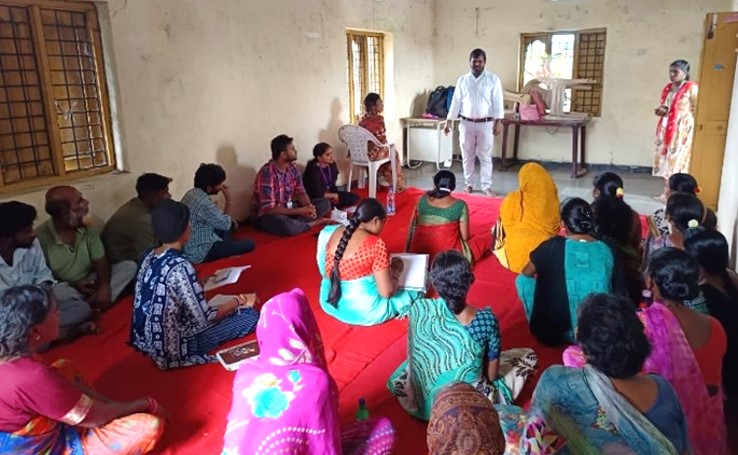
During the course of introductions, some residents informed that, they receive muddy water on certain days, leading them to buy mineral water from a nearby water plant. The service reservoir for this area is far away. They receive supply once every 3 days. The training was on no-supply day.
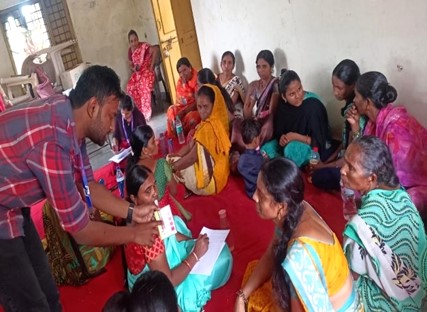
Surendra Nagar: Demonstration of RC Testing
IHS Team explained about potential for microbial contamination due to vulnerabilities in distribution system and the importance of residual chlorine for water safety. Some residents brought samples of their drinking water (stored municipality supply) and mineral water from the nearby plant, for testing. RC in stored water was nil or low. The Basti Mitra was trained in sample collection procedure. With help of water supply observation form distributed to all participants, IHS-team explained important points about turbidity in supply, if any; colour, smell, water pressure and duration. Participants filled in the water supply observation form based on their recall of recent water supply to their households or public standposts in their locality. Participants were informed, how to file a complaint to water board and HMWSSB toll-free number was share will all.
Gandhi Nagar:
MARI’s Training Officer (D.V. Ramana) & Cluster Facilitator (Shravanthi Vemula), Basti Mitra (Dhanraj) present.
IHS Laboratory Team: Ms. G. Bhuvaneshwari, Intern in Environmental Management & Chemical Laboratory Technique (Resource Person).
Date: 02-12-2024; Participants: 30
Gandhi Nagar: Explanation of Water Supply Observation Form, RC Testing & Sample Collection.
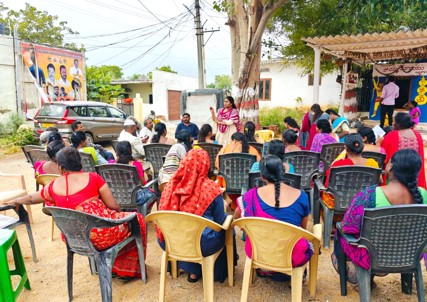
Participants informed that, they receive water every four days. There are occasional issues with water quality, such as muddy water and an unusual taste. The service reservoir for this locality is far away in Moulali.
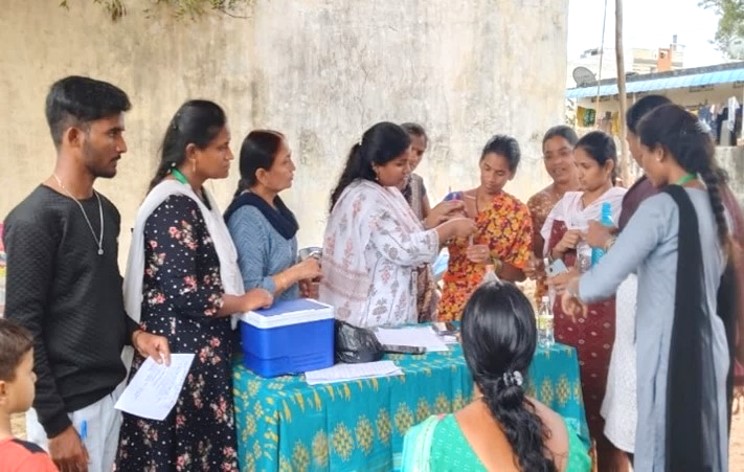
Gandhi Nagar: Demonstration of RC Testing
IHS Resource person explained the significance of residual chlorine (RC) to protect quality of metro water supply. Demonstrated residual chlorine testing guiding participants through each step. Explained, how to read RC test result by comparing DPD colour development in test tube with colour comparator chart. Distributed live metro water supply observation form, explained each item and clarified participant-doubts. Basti Mitra’s helped participants in filling out the consumer-observation sheet based on their respective experience of live metro water supply. Collected samples of live metro water supply, for laboratory testing. Explained HMWSSB complaint registration system and shared the toll-free number.
Shanti Nagar:
MARI’s Cluster Facilitator (Amrapali) & Basti Mitras (B. Jyothi, S. Swathi), present.
IHS Laboratory Team: Ms. G. Bhuvaneshwari, Intern in Environmental Management & Chemical Laboratory Technique (Resource Person); Ms E. Shravanthi, Associate Microbiologist (Observer).
Date: 03-12-2024; Participants: 30
Shanti Nagar: Demonstration of RC Testing.
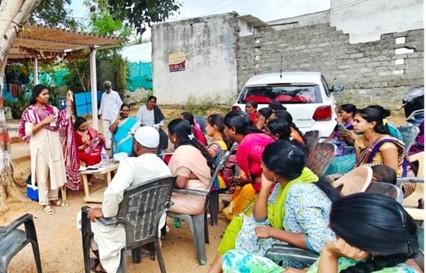
Participants informed that, they receive water every three days. Sometimes the water is muddy, and the tastes different. The overhead tank (service reservoir) for this locality is not being cleaned.
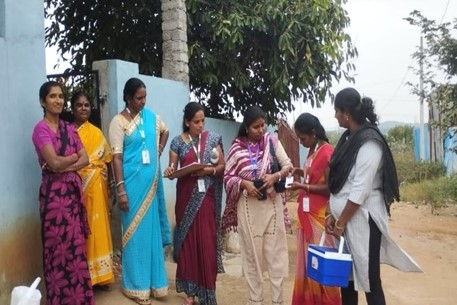
Shanti Nagar: RC Testing - Practical
IHS-team distributed water supply observation forms. Live metro water supply was available at the time. Volunteers helped participants read and fill the forms based on their observation of live metro water supply. IHS-team explained about importance of residual chlorine for municipal water safety and demonstrated test procedure by performing RC tests of 10 live metro supply samples. RC ranged from 0.3 to 0.5 mg/L. Collected samples for microbial testing in laboratory. IHS-team also demonstrated hand washing and explained its importance for good health.
Yadamma Nagar:
MARI’s Cluster- Coordinator (Devi Sunkari) & Basti Mitra (E. Rajender), present.
IHS Laboratory Team: Ms Ch. Madhuri, Associate Microbiologist (Resource Person); Ms B. Bhargavi, Lead Microbiologist (Observer).
Date: 03-12-2024; Participants: 30
Yadamma Nagar: Explanation of Water Supply Observation Form, RC Testing & Sample Collection.
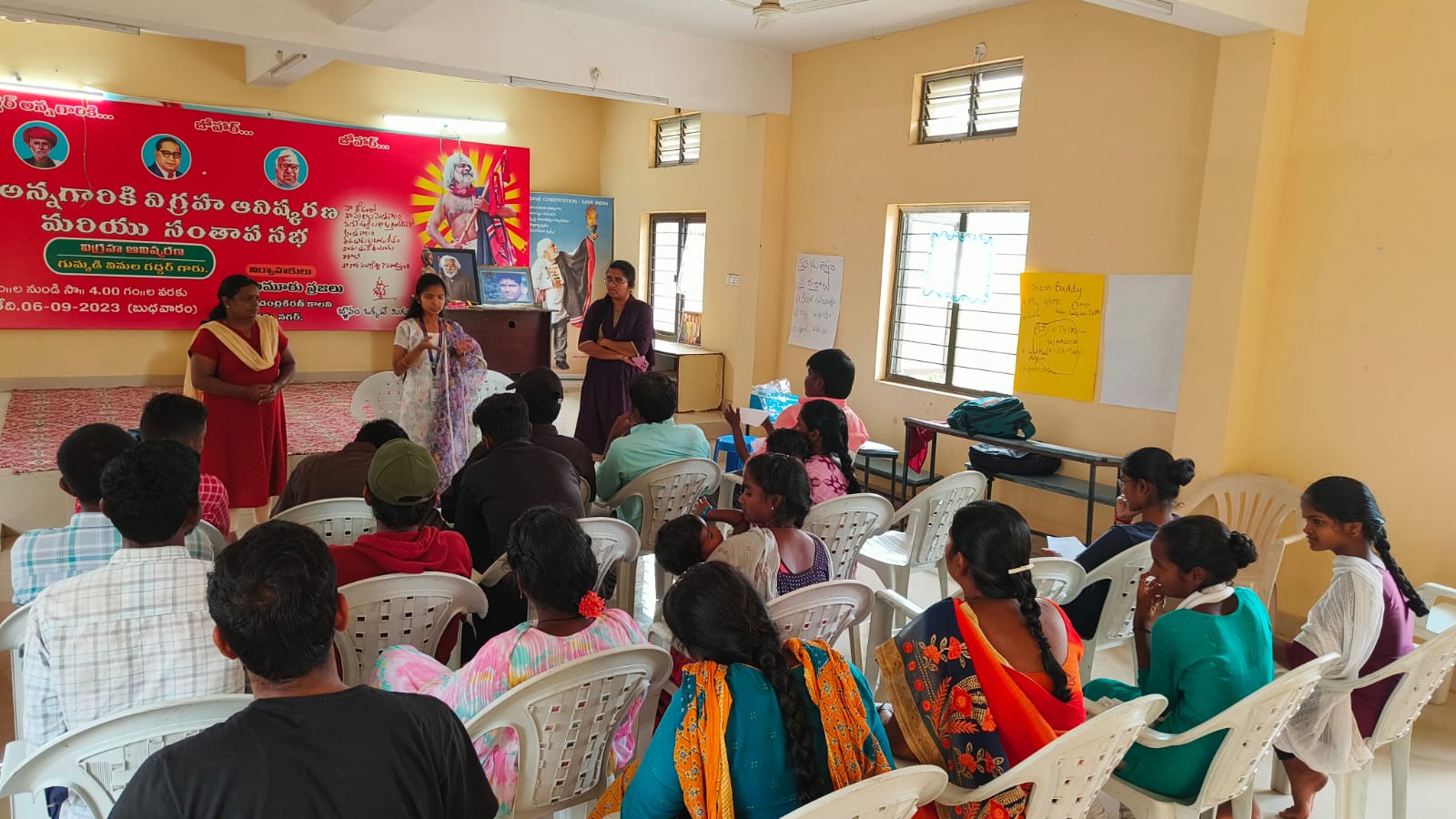
Most residents used municipal water for cooking, bathing, and general purposes but relied on RO water for drinking. Some houses, that did not have door numbers, fetched water from neighbours. This was a no-supply day. Households had stored water from previous day’s supply.

Yadamma Nagar: RC Testing - Practical
IHS Team visited households and demonstrated residual chlorine testing using stored water. In the afternoon meeting, explained about the journey of municipal water from rivers to households, the importance of residual chlorine, and the risk of sewage contamination. Using pictorial illustrations, demonstrated how microbial contamination is detected in labs. Distributed water supply - rating sheets and explained how consumers can assess and describe observable aspects of their water supply. Shared contact information for raising complaints to HMWSSB. One resident recorded the session to share in their slum’s WhatsApp group for those who couldn’t attend.
BJR Nagar:
MARI’s Training Officer (D.V. Ramana) & Basti Mitras (Kurmamma, Sandhya), present.
IHS Laboratory Team: Mr. PS Revanth Kumar, Intern in Environmental Management & Chemical Laboratory Technique (Resource Person); Ms E. Shravanthi, Associate Microbiologist (Observer).
Date: 03-12-2024; Participants: 30
BJR Nagar: Participants - Group Photo.

Participants informed that, they receive live water during morning hours two times a week. The overhead tank (service reservoir) is nearby.
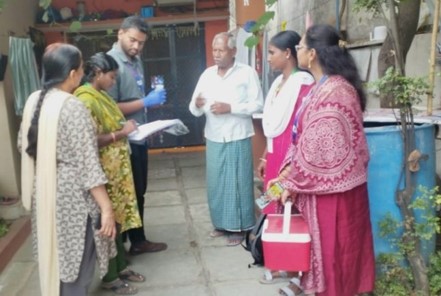
BJR Nagar: Filling-in of Household Sample Collection Record
IHS Team distributed the water supply observation form (turbidity questionnaire) and explained to participants, how to observe& record appearance, smell, turbidity of live metro supply. Participants filled in the observation form based on their experience of live water supply to their households. Demonstrated residual chlorine testing and showed how to compare DPD colour development in test tube with colour chart. Most RC tests of stored water samples showed nil or low values. Explained about Metro Water Board complaint procedure and shared telephone number.
-------------
References:
- Albus, K, et al. 2019. Usability of Existing Volunteer Water Monitoring Data: What Can the Literature Tell Us? Citizen Science: Theory and Practice, 4(1): 28, pp. 1–10. DOI: https://doi.org/10.5334/cstp.222
- Safe Water Network. 2016. Drinking Water Supply for Urban Poor: City of Hyderabad. Report prepared by Pooja (Sarvotham) Singh, Monitoring & Evaluation Manager, and Poonam Sewak, Knowledge & Partnerships Manager, Safe Water Network Safe Water Network; 2016. Available at https://safewaternetwork.org/knowledge-hub/hyderabad-city-report-2016/
- Times News Network, 2017. 60% water samples fail purity test, even faecal bacteria present in some instances. Times of India. Hyderabad; 2017 Oct 22; Times City, Hyderabad, Civic Issues. Available at https://timesofindia.indiatimes.com/city/hyderabad/60-water-samples-fail-purity-test-even-faecal-bacteria-present-in-some-instances/articleshow/61169079.cms
- Sreepada SV and Goswami S, 2018. Redefining Access to Water: Case of Slum Dwellers of Hyderabad. in. Proceedings of the 12th World Congress of the Regional Science Association International (RSAI). 2018. Available at https://www.researchgate.net/publication/333644239
- GOI Jal Shakti, 2021. Annex-III in Drinking Water Quality Monitoring & Surveillance Framework. New Delhi: Ministry of Jal Shakti, Govt. of India (GoI Jal Shakti); 2021 Oct. Available at https://jaljeevanmission.gov.in/sites/default/files/guideline/WQMS-Framework.pdf.
